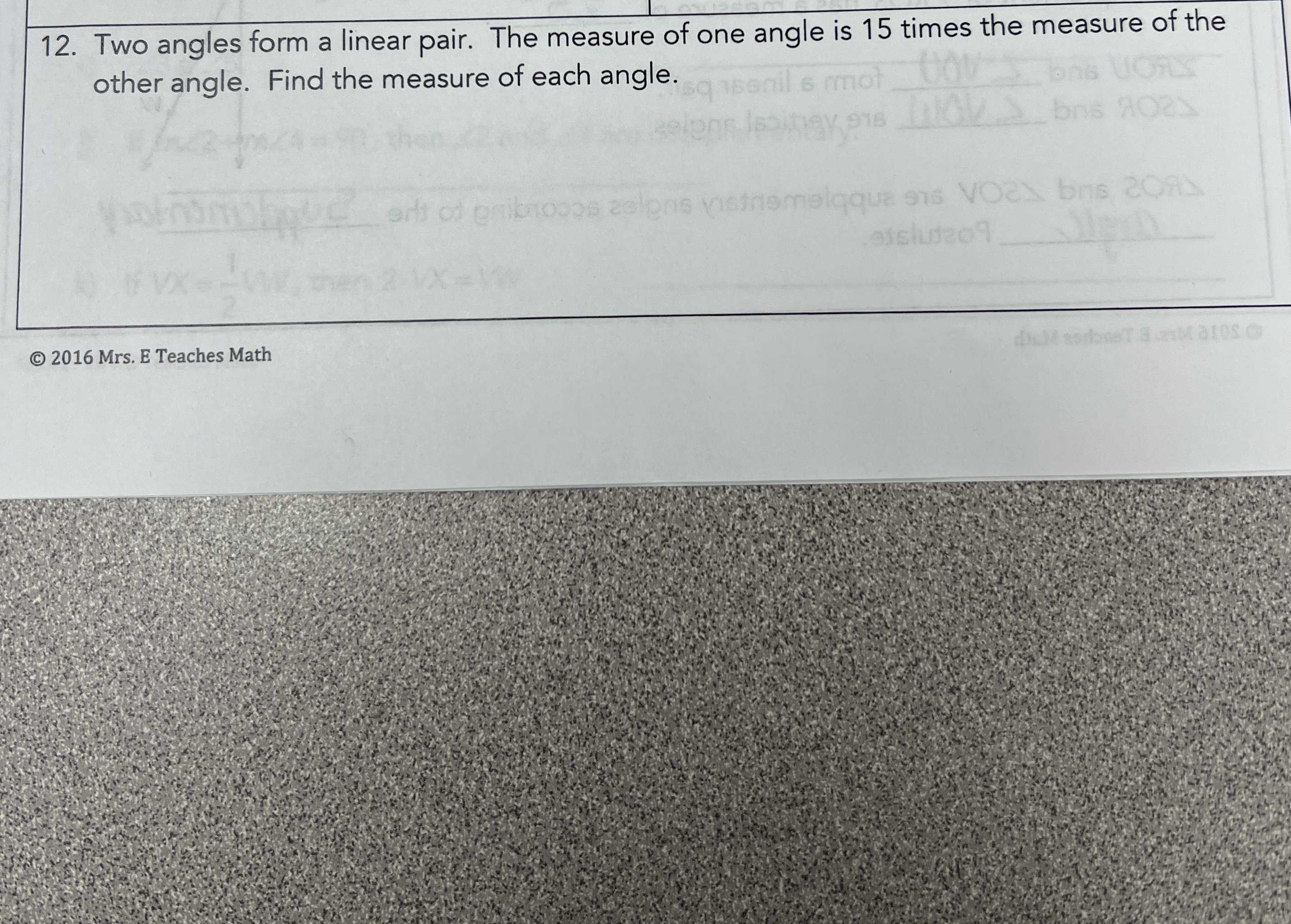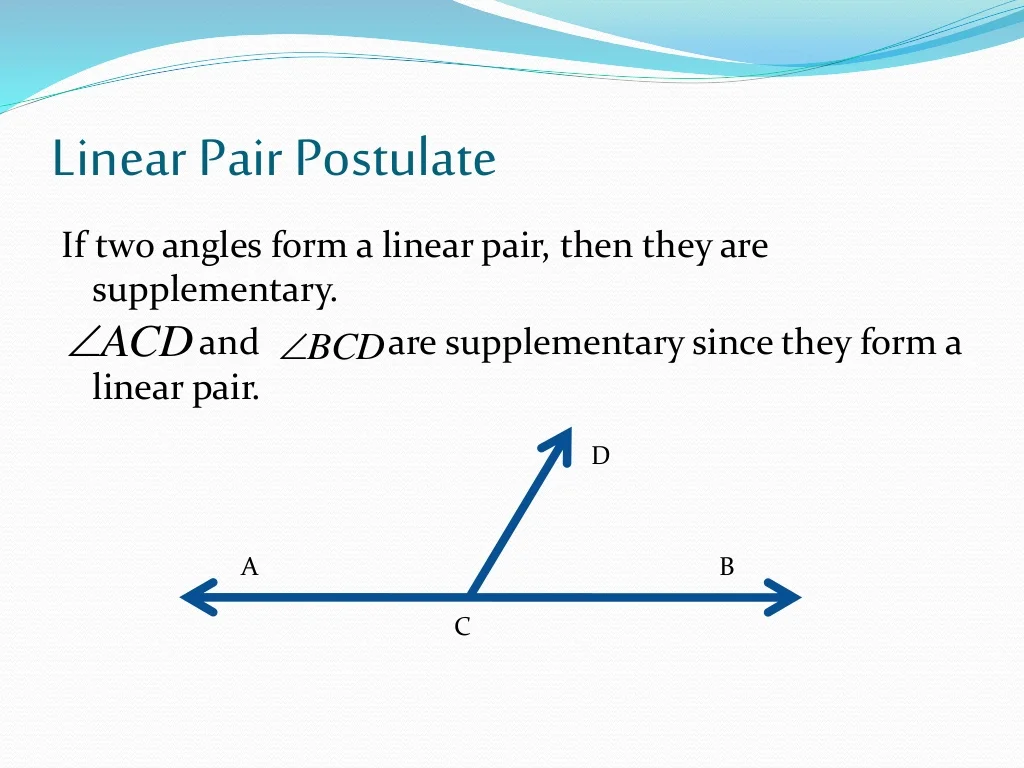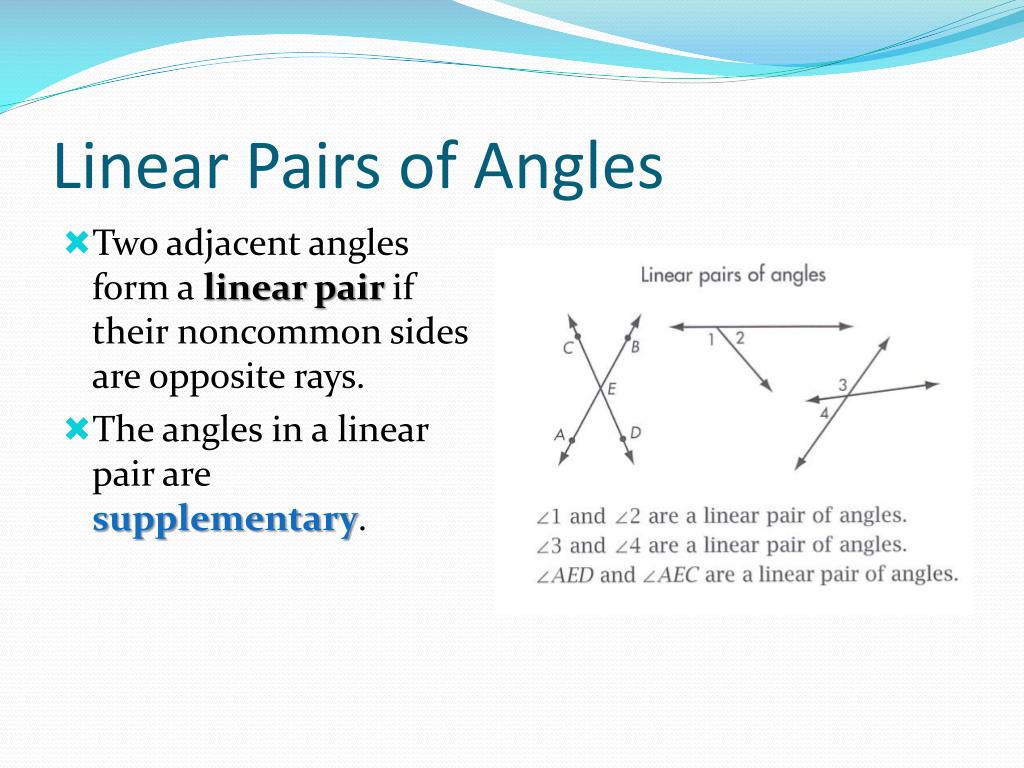Two Angles Form A Linear Pair
Two Angles Form A Linear Pair - The sum of two angles in the linear pair is always 180 degrees. If the measure of one. A point's location on the coordinate plane is indicated by an ordered pair,. (i) angles forming a linear pair are supplementary. Web up to 6% cash back a linear pair is a pair of adjacent angles formed when two lines intersect. Web when two lines intersect each other, the adjacent angles make a linear pair. 1/3 x = measure of other angle. In the figure, ∠ 1 and ∠ 2 form a linear pair. (ii) if two adjacent angles are equal, then each angle. Linear pairs are adjacent angles who share a common ray and whose opposite rays.
Web the two angles make a linear pair, so the sum of measures of the two angles is 180°\text{\textdegree}°. In the diagram below, ∠abc and ∠dbe are supplementary since 30°+150°=180°,. X + 1/3x = 180. Web however, just because two angles are supplementary does not mean they form a linear pair. A line is 180 degrees. Web when two lines intersect each other, the adjacent angles make a linear pair. If two angles form a linear pair, then the sum of the degree measures of the angles. So do ∠ 2 and ∠ 3 , ∠ 3 and ∠ 4 , and. In the figure, ∠ 1 and ∠ 2 are supplementary by the. 1/3 x = measure of other angle.
So that means <1 + <2 =180 but let’s call those. Web in math, the linear pair postulate or linear pair theorem, says the same in mathematical terms. If two angles forms a linear pair, this means that the sum of the angles is 180°. A line is 180 degrees. A point's location on the coordinate plane is indicated by an ordered pair,. If two angles form a linear pair, then the measures of the angles. Web however, just because two angles are supplementary does not mean they form a linear pair. Web up to 6% cash back the supplement postulate states that if two angles form a linear pair , then they are supplementary. Web first we need to define what is a linear pair? The measure of one angle is 1/3 the measure of the other angle.
Name two angles that form a linear pair.
1/3 x = measure of other angle. A linear pair are two angles that makes a line. In the figure, ∠ 1 and ∠ 2 are supplementary by the. Web 4.9 (928) retired math prof. X + 1/3x = 180.
The two angles below form a linear pair, and the expressions are
The measure of one angle is 1/3 the measure of the other angle. Web however, just because two angles are supplementary does not mean they form a linear pair. Supplementary angles are two angles whose same is 180o. If two angles form a linear pair, then the sum of the degree measures of the angles. The sum of linear pairs.
Two angles form a linear pair. The measure of one CameraMath
Linear pairs are adjacent angles who share a common ray and whose opposite rays. Web the smaller angle measures the larger angle measures 2)two angles form a linear pair. The sum of two angles in the linear pair is always 180 degrees. If two angles forms a linear pair, this means that the sum of the angles is 180°. If.
Linear pair
If the measure of one. Web the smaller angle measures the larger angle measures 2)two angles form a linear pair. Linear pairs are adjacent angles who share a common ray and whose opposite rays. A line is 180 degrees. If two angles form a linear pair, then the sum of the degree measures of the angles.
Linear Pair lines and angles This postulate is sometimes call the
X = measure of one angle. X + 1/3x = 180. The measure of one angle is 1/3 the measure of the other angle. 1/3 x = measure of other angle. So that means <1 + <2 =180 but let’s call those.
Linear pair
Web determine whether each pair of angles can form a linear pair of angles when combined. Web which statements are true regarding undefinable terms in geometry? A linear pair are two angles that makes a line. Web the smaller angle measures the larger angle measures 2)two angles form a linear pair. So do ∠ 2 and ∠ 3 , ∠.
PPT Geometry Review Angles and Parallel Lines PowerPoint Presentation
Web determine whether each pair of angles can form a linear pair of angles when combined. In the figure, ∠ 1 and ∠ 2 form a linear pair. Web in math, the linear pair postulate or linear pair theorem, says the same in mathematical terms. If two angles forms a linear pair, this means that the sum of the angles.
Which statement is true about this argument? Premises If two angles
If the measure of one. If two angles form a linear pair, then the measures of the angles. Web in math, the linear pair postulate or linear pair theorem, says the same in mathematical terms. Web up to 6% cash back the supplement postulate states that if two angles form a linear pair , then they are supplementary. Web when.
Definition and Examples of Linear Pairs YouTube
A point's location on the coordinate plane is indicated by an ordered pair,. Linear pairs are adjacent angles who share a common ray and whose opposite rays. So do ∠ 2 and ∠ 3 , ∠ 3 and ∠ 4 , and. Web which statements are true regarding undefinable terms in geometry? Web 4.9 (928) retired math prof.
📈In which diagram do angles 1 and 2 form a linear pair?
Web up to 6% cash back a linear pair is a pair of adjacent angles formed when two lines intersect. Web first we need to define what is a linear pair? X + 1/3x = 180. Web which of the following statements are true., (t) and which are false (f)? The sum of linear pairs is 180°.
Web 4.9 (928) Retired Math Prof.
Web up to 6% cash back the supplement postulate states that if two angles form a linear pair , then they are supplementary. A linear pair are two angles that makes a line. The sum of linear pairs is 180°. Web up to 6% cash back a linear pair is a pair of adjacent angles formed when two lines intersect.
Web There Are Some Properties Of Linear Pair Of Angles And They Are Listed Below:
Web when two lines intersect each other, the adjacent angles make a linear pair. If the measure of one. X + 1/3x = 180. A point's location on the coordinate plane is indicated by an ordered pair,.
If Two Angles Form A Linear Pair, Then The Measures Of The Angles.
Web determine whether each pair of angles can form a linear pair of angles when combined. Web the two angles make a linear pair, so the sum of measures of the two angles is 180°\text{\textdegree}°. If we merge the two angles, they will form a larger angle, \angle. The sum of two angles in the linear pair is always 180 degrees.
(I) Angles Forming A Linear Pair Are Supplementary.
Supplementary angles are two angles whose same is 180o. If two angles forms a linear pair, this means that the sum of the angles is 180°. Web which of the following statements are true., (t) and which are false (f)? It should be noted that all linear pairs are supplementary because.









